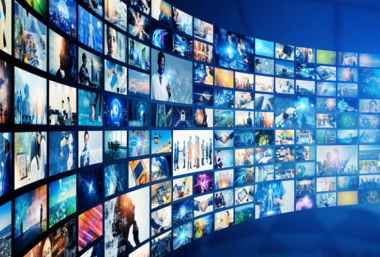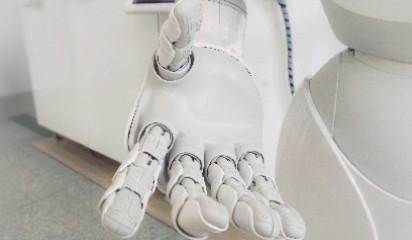Jason M Allen told the New York Times ‘art was dead’ after winning the Colorado State Art Fair's competition with his entry ‘Théâtre D'opéra Spatial’. He used Artificial Intelligence (AI) driven web application 'MidJourney' to create the piece:

Allen’s use of AI to create the work which won the competition drew attention, and led to significant debates about the ethics of AI and art.
How is an AI used to create images?
While all AI applications will all have nuances in how they were trained, and what they learn from, it is likely that the training will have involved a diffusion model and a database of millions of images.
Diffusion models teach the AI to generate data that is similar to the data they have been trained on. The ‘training’ involves the AI destroying the structure of an image by adding noise – think slowly moving an aerial on a TV, adding static black and white dots to the image on the screen. The AI then removes the ‘noise’ at each step. After it has done this millions of times it learns how to estimate the original image from pure random data.
The concept is easier to understand with a visual – below is a representation of the process using AJ Park’s logo as the input data:

You can see the original image being ‘destroyed’ by the addition of noise, and a ‘new’ image being created from data.
While the creating and programming of an AI is clearly extremely complex, their use is not. Midjourney allows the user to plug in word prompts and uses them to generate four images. It is one of a number of such image generators, others include: Stable Diffusion, Deviant Art, DreamUp and DALL-E.
For example, we entered the prompt “black lightning strikes a tree, while the world burns and two black ravens look on, so long and thanks for all the fish” into Midjourney[1]. The resulting four images were:

While the MidJourney AI is unlikely to have understood the reference to The Hitchhikers Guide to the Galaxy (note the distinct lack of dolphins in the produced images) we, the authors of this article, would never have been able to produce any of the above images with pen and paper.
The use of AI to generate art raises a number of moral, ethical and philosophical questions. What impact will AI have on artists? Will AI discourage new artists? Do the images even constitute art? What are the copyright implications?
Or another one for intellectual property lawyers, what happens when a person uses a trade mark in a prompt and then seeks to use or register the resulting image as a trade mark? Following this, what happens when the AI that suggest products to consumers then associates the two trade marks, even though a consumer may not?
 Using MidJourney with prompt – “McDonalds Emblem but not McDonalds”
Using MidJourney with prompt – “McDonalds Emblem but not McDonalds”
Copyright and AI-created works
While these issues will need to be debated and decided on as a society, some of the legal issues are now being tested.
On 13 January 2023 three artists filed a class action lawsuit in the California Federal Court against the companies responsible for AI programs Stable Diffusion, Midjourney and DreamUp.
The artists claim that:
- Stability AI, the company behind Stable Diffusion, downloaded or otherwise acquired billions of copyrighted images without permission to create the Stable Diffusion AI. The acquired images became ‘training images’ for the AI.
- Stability trained the AI on the training images and caused them to be stored and incorporated into the AI
- Stable Diffusion, when asked by prompts to produce an image, produces ‘seemingly new’ images through a mathematical software process. The new images are based entirely on the training images and are derivative works of the images used by Stable Diffusion.
- The AI-created images compete in the market place with the original images.
- That a user can now prompt the AI to create work ‘in the style of an artist’.
- That ‘all AI Image Products’ operate in the same way.
At the time of writing this article, the Defendants had not responded to the claims.
However, it is plausible the Defendants might argue:
- That the AI does not copy or create collages but creates original works.
- That even if the use of the training images did breach the owners copyright, that the use falls under the doctrine of ‘fair use’. In the United States the fair use doctrine allows the use of copyright protected material under certain circumstances without the owner’s permission. There are four factors to the doctrine:
- The purpose and character of the use – does the AI make copies of original works or is the use transformative? Does it add new expression or meaning to the work?
- The nature of the copyrighted work – copied material that is factual rather than artistic is more likely to be considered ‘fair’
- The amount and substantiality of the portion used in relation to the copyrighted work as a whole – does the AI copy small bits of the original works or take the ‘heart’ of the work?
- The effect the use will have on the potential market for or value of the original work – will the images produced by the AI have a negative impact on the value, or marketplace of, the original art works?
It is likely the case will garner publicity, and further challenges to the use of copyrighted works by AI may arise.
The New Zealand approach
New Zealand’s approach to copyright differs from the United States, for instance, New Zealand does not require works to be registered to be protected by copyright. Instead, in New Zealand, copyright is a property right that exists in an original work as soon as the work is created.
New Zealand also does not recognise the ‘Doctrine of Fair Use’ as a defence for copying copyrighted works. The Copyright Act 1994 (the Act) permits certain activities in relation to copyright works, these include:
- Incidental copying
- Fair dealing with a work for the purpose of criticism, review and news reporting
- Fair dealing with a work for the purpose of research or private study
- Where the copying is for educational purposes and follows the requirements of the Act.
Copyright protects the expression of ideas or information, not the underlying idea itself. It is likely that an infringement case in New Zealand would revolve around whether the use of images (copyright works) by the AI amounted to copying a substantial part of the works – i.e. has the AI copied an important or distinctive part of an earlier copyright work to create the new image?
Section 5 of the Act defines ‘meaning of author’. Under section 5(2)(a) of the Act ‘artistic work that is computer-generated’ is covered. This section confirms that the ‘author of a work’ is the person who creates it and, for computer-general artistic works, the author is ‘the person by whom the arrangements necessary for the creation of the work are undertaken’.
Computer-generated works are also defined under the Act. Section 2 (interpretation) provides:
computer-generated, in relation to a work, means that the work is generated by computer in circumstances such that there is no human author of the work
This means copyright can and will subsist in AI generated images. The question will be whether the created work is sufficiently original and hasn’t copied a substantial part of any earlier copyright work. Other factors will also impact the ‘author’s’ rights in the AI-created images – for instance, will the author be the end user inputting data into the AI program? Midjourney has a number of subscription options which give different levels of rights and ownership to the end user.
Conclusion
While some may argue that art is dead because of AI, the debate around the impacts of AI software and how it interacts with the law is very much alive.
In the United States some of these questions are already being asked before the courts and will hopefully soon be answered. Those answers could have an impact on how we, in New Zealand, respond to this new form of image creation. Watch this space!
[1] “So long and thanks for all the fish” is the last message left by the dolphins for humanity in the book The Hitchhikers Guide to the Galaxy by Douglas Adams. The Hitchhiker's Guide to the Galaxy is a comedy science fiction series which follows the misadventures of the last surviving man, Arthur Dent, following the demolition of the planet Earth by a Vogon constructor fleet to make way for a hyperspace bypass.



